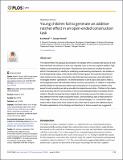Files in this item
Young children fail to generate an additive ratchet effect in an open-ended construction task
Item metadata
| dc.contributor.author | Reindl, Eva | |
| dc.contributor.author | Tennie, Claudio | |
| dc.date.accessioned | 2018-06-19T10:30:06Z | |
| dc.date.available | 2018-06-19T10:30:06Z | |
| dc.date.issued | 2018-06-18 | |
| dc.identifier | 253394569 | |
| dc.identifier | 474162c1-84b6-4994-bc16-e177047e0a02 | |
| dc.identifier | 85048829594 | |
| dc.identifier | 000435528600011 | |
| dc.identifier.citation | Reindl , E & Tennie , C 2018 , ' Young children fail to generate an additive ratchet effect in an open-ended construction task ' , PLoS One , vol. 13 , no. 6 , e0197828 . https://doi.org/10.1371/journal.pone.0197828 | en |
| dc.identifier.issn | 1932-6203 | |
| dc.identifier.other | RIS: urn:71CCA5EDD18EC9A05D9351F120BC001F | |
| dc.identifier.uri | https://hdl.handle.net/10023/14242 | |
| dc.description | This work was supported by a PhD studentship of the College of Life and Environmental Sciences, University of Birmingham, and by the Economic and Social Research Council (ESRC) (ES/K008625/1). | en |
| dc.description.abstract | The ratchet effect–the gradual accumulation of changes within a cultural trait beyond a level that individuals can achieve on their own–arguably rests on two key cognitive abilities: high-fidelity social learning and innovation. Researchers have started to simulate the ratchet effect in the laboratory to identify its underlying social learning mechanisms, but studies on the developmental origins of the ratchet effect remain sparse. We used the transmission chain method and a tower construction task that had previously been used with adults to investigate whether “generations” of children between 4 and 6 years were able to make a technological product that individual children could not yet achieve. 21 children in a baseline and 80 children in transmission chains (each consisting of 10 successive children) were asked to build something as tall as possible from plasticine and sticks. Children in the chains were presented with the constructions of the two preceding generations (endstate demonstration). Results showed that tower heights did not increase across the chains nor were they different from the height of baseline towers, demonstrating a lack of improvement in tower height. However, we found evidence for cultural lineages, i.e., construction styles: towers within chains were more similar to each other than to towers from different chains. Possible explanations for the findings and directions for future research are suggested. | |
| dc.format.extent | 22 | |
| dc.format.extent | 5998366 | |
| dc.language.iso | eng | |
| dc.relation.ispartof | PLoS One | en |
| dc.subject | BF Psychology | en |
| dc.subject | NDAS | en |
| dc.subject.lcc | BF | en |
| dc.title | Young children fail to generate an additive ratchet effect in an open-ended construction task | en |
| dc.type | Journal article | en |
| dc.contributor.institution | University of St Andrews. School of Psychology and Neuroscience | en |
| dc.identifier.doi | 10.1371/journal.pone.0197828 | |
| dc.description.status | Peer reviewed | en |
This item appears in the following Collection(s)
Items in the St Andrews Research Repository are protected by copyright, with all rights reserved, unless otherwise indicated.

